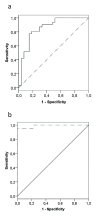Meropenem and piperacillin/tazobactam prescribing in critically ill patients: does augmented renal clearance affect pharmacokinetic/pharmacodynamic target attainment when extended infusions are used?
- PMID: 23642005
- PMCID: PMC4056350
- DOI: 10.1186/cc12705
Meropenem and piperacillin/tazobactam prescribing in critically ill patients: does augmented renal clearance affect pharmacokinetic/pharmacodynamic target attainment when extended infusions are used?
Abstract
Background: Correct antibiotic dosing remains a challenge for the clinician. The aim of this study was to assess the influence of augmented renal clearance on pharmacokinetic/pharmacodynamic target attainment in critically ill patients receiving meropenem or piperacillin/tazobactam, administered as an extended infusion.
Methods: This was a prospective, observational, pharmacokinetic study executed at the medical and surgical intensive care unit at a large academic medical center. Elegible patients were adult patients without renal dysfunction receiving meropenem or piperacillin/tazobactam as an extended infusion. Serial blood samples were collected to describe the antibiotic pharmacokinetics. Urine samples were taken from a 24-hour collection to measure creatinine clearance. Relevant data were drawn from the electronic patient file and the intensive care information system.
Results: We obtained data from 61 patients and observed extensive pharmacokinetic variability. Forty-eight percent of the patients did not achieve the desired pharmacokinetic/pharmacodynamic target (100% fT>MIC), of which almost 80% had a measured creatinine clearance>130 mL/min. Multivariate logistic regression demonstrated that high creatinine clearance was an independent predictor of not achieving the pharmacokinetic/pharmacodynamic target. Seven out of nineteen patients (37%) displaying a creatinine clearance>130 mL/min did not achieve the minimum pharmacokinetic/pharmacodynamic target of 50% fT>MIC.
Conclusions: In this large patient cohort, we observed significant variability in pharmacokinetic/pharmacodynamic target attainment in critically ill patients. A large proportion of the patients without renal dysfunction, most of whom displayed a creatinine clearance>130 mL/min, did not achieve the desired pharmacokinetic/pharmacodynamic target, even with the use of alternative administration methods. Consequently, these patients may be at risk for treatment failure without dose up-titration.
Figures
Comment in
-
Antibiotics for the critically ill: more than just selecting appropriate initial therapy.Crit Care. 2013 May 23;17(3):146. doi: 10.1186/cc12698. Crit Care. 2013. PMID: 23714588 Free PMC article.
References
-
- Vincent J-L, Rello J, Marshall J, Silva E, Anzueto A, Martin CD, Moreno R, Lipman J, Gomersall C, Sakr Y, Reinhart K. EPICII Group of Investigators. International study of the prevalence and outcomes of infection in intensive care units. JAMA. 2009;17:2323–2329. doi: 10.1001/jama.2009.1754. - DOI - PubMed
Publication types
MeSH terms
Substances
LinkOut - more resources
Full Text Sources
Other Literature Sources
Medical





